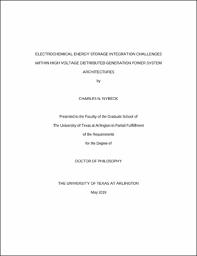| dc.description.abstract | Future stationary and mobile microgrids may be deployed with a number of high power electrical
loads that operate transiently. The transient nature of the loads will impart high stress on a
microgrid’s power system, possibly pushing it outside of the acceptable power quality standards.
To restore power quality and increase system reliability, it is being proposed that electrochemical
energy storage systems be used as a buffer. Energy storage systems that store a great deal of energy
and could be used with open circuit potentials (OCPs) as high as 1 kV. Since size and weight on a
mobile microgrid is limited, it is desired that energy storage systems be designed as compactly as
possible.
Lithium-ion batteries (LIBs) are among those with a great deal of promise due to their high
combined power and energy density that allows them to be very versatile as both the source and
sink of high power aboard a mobile platform. Lithium-ion batteries are available in many
different chemistries and each offers its own advantages and disadvantages with respect to
voltage, power density, energy density, impedance, and safety. In most energy storage
application LIBs should be considered although they may not be the most optimal solution.
3
Another electrochemical energy storage option of interest is the use of ultracapacitors (UCs).
Although they are not as energy dense as LIBs, they do offer very high power densities, have very
low impedance, and have a long cycle life when cycled at high rates. Due to their high energy
densities, LIBs are a more viable solution for loads operating in continuous modes of operation,
like during operational scenarios requiring greater than a second or so or conduction. On the other
hand, because of their very low equivalent series resistance (ESR), UCs are better suited for
sourcing transient loads that require high power in very short duration, i.e. less than a second. The
research presented here is comprised of three different tests that provide insight into
electrochemical energy storage integration challenges within high voltage distributed generation
power system architectures.
These energy storage systems will likely be located in a different area of the microgrid than the
loads they provide power to. Long cables will be used to connect busses that provide power to
different loads introducing inductance to the system based on the length and diameter of those
cables. High power electrical loads combined with the inductance introduced can lead to voltage
transients over the energy storage systems OCP. The transients induced may even cause damage
to electrochemical energy storage devices used to buffer the load and could result in punch through
on a battery’s separator causing the cell to fail, possibly leading to severe damage to system
components.
Battery failure often leads to thermal runaway, a process in which an increase in temperature
changes the conditions in a way that causes a further increase in temperature [1]. Each of the
different battery chemistries fail in a different way and each has a different level of thermal
runaway volatility. When a LIB fails, the high temperature leads to an increase in pressure within
the cell that causes an internal burst diaphragm to rupture in attempt to relieve pressure and prevent
4
further thermal increase. Rupturing of the burst diaphragm releases internal gases in the form of
vented organic electrolyte compounds to the surrounding environment. The chemical makeup of
the vented gas is chemistry dependent with different levels of toxicity and flammability.
In most lithium ion batteries, the electrolyte solution consists of combinations of linear and cyclic
alkyl carbonates including ethylene carbonate, dimethyl, diethyl, and ethyl-methyl carbonates (EC,
DMC, DEC, and EMC) as well as electrolyte salts such as LiPF6 or LiClO4 [2]. Over a cell’s useful
lifetime, the electrolyte decomposes slowly, however when they are exposed to extreme voltage
or temperature conditions, the electrolytes can react rapidly with the active electrode materials to
release significant heat and gas [2, 3]. Thermal runaway begins as temperatures in excess of 200°C
are reached, however breakdown of the solvents can occur slightly sooner. During these processes,
many different gas products are produced, most of which are hydrocarbons with various levels of
toxicity and flammability. Due to the dangerous nature of electrochemical energy storage
integration challenges within high voltage distributed generation power system architectures, the
research presented here is comprised of three different tests that provide insight into potential
methods and solutions. | |


